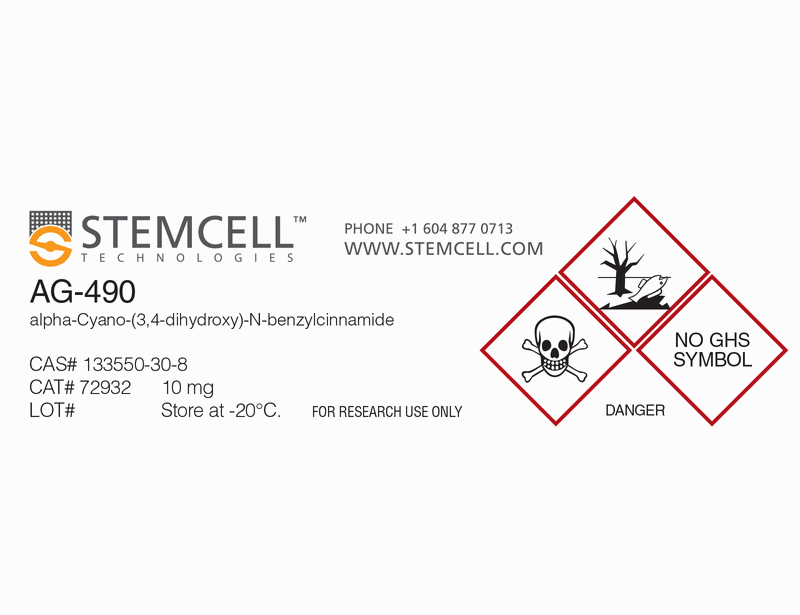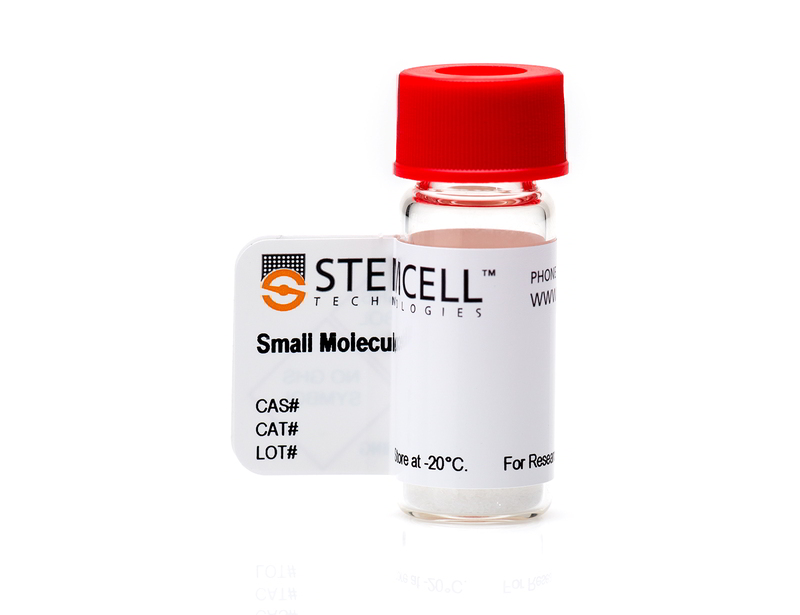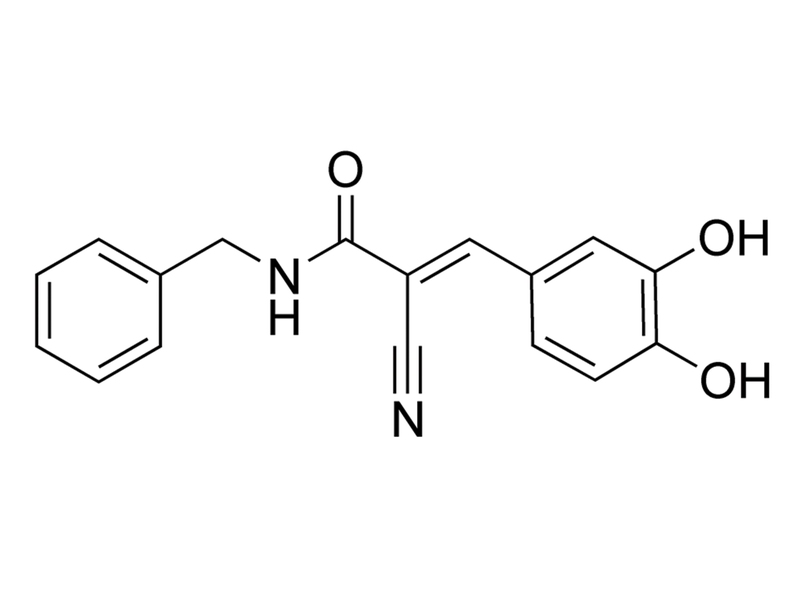概要
AG-490 is a member of the tyrphostin family of small molecule inhibitors of tyrosine kinases including EGFR (Gazit et al.), HER2 (Gazit et al.), JAK2 (Burger et al.), JAK3 (Brown et al.), and STAT5a/b (Wang et al.) with IC₅₀ values of 0.1, 13.5, 11 and 12 μM, respectively. AG-490 does not inhibit LCK, LYN, BTK, SYK, or SRC tyrosine kinases (Meydan et al.).
DIFFERENTIATION
· Induces differentiation of mouse (OG2) embryonic stem cells, with LIF and BMP4 (Chen et al.).
CANCER RESEARCH
· Blocks growth of acute lymphoblastic leukemia pre-B cells by inducing programmed cell death, via inhibition of JAK2 (Meydan et al.).
· Inhibits proliferation of cervical carcinoma cell lines (Soto-Cruz et al.).
· Inhibits STAT3 phosphorylation and induced translocation of beta-catenin to the cytoplasm in the colorectal cell line SW480 (Kawada et al.).
· Induces S phase arrest of GL15 glioblastoma cells via JAK2 inhibition (Sciaccaluga et al.).
· Inhibits EGF-dependant proliferation of NIH3T3 cell lines (Gazit et al.).
· Blocks IL-2 induced thymidine incorporation in T-cell lines (Wang et al.).
DIFFERENTIATION
· Induces differentiation of mouse (OG2) embryonic stem cells, with LIF and BMP4 (Chen et al.).
CANCER RESEARCH
· Blocks growth of acute lymphoblastic leukemia pre-B cells by inducing programmed cell death, via inhibition of JAK2 (Meydan et al.).
· Inhibits proliferation of cervical carcinoma cell lines (Soto-Cruz et al.).
· Inhibits STAT3 phosphorylation and induced translocation of beta-catenin to the cytoplasm in the colorectal cell line SW480 (Kawada et al.).
· Induces S phase arrest of GL15 glioblastoma cells via JAK2 inhibition (Sciaccaluga et al.).
· Inhibits EGF-dependant proliferation of NIH3T3 cell lines (Gazit et al.).
· Blocks IL-2 induced thymidine incorporation in T-cell lines (Wang et al.).
技术资料
| Document Type | 产品名称 | Catalog # | Lot # | 语言 |
|---|---|---|---|---|
| Product Information Sheet | AG-490 | 72932, 72934 | All | English |
| Safety Data Sheet | AG-490 | 72932, 72934 | All | English |
数据及文献
Publications (9)
Molecular Cancer Therapeutics 2009
Janus kinase inhibitor INCB20 has antiproliferative and apoptotic effects on human myeloma cells in vitro and in vivo
Abstract
Abstract
Protein tyrosine kinases of the Janus kinase (JAK) family are associated with many cytokine receptors, which, on ligand binding, regulate important cellular functions such as proliferation, survival, and differentiation. In multiple myeloma, JAKs may be persistently activated due to a constant stimulation by interleukin (IL)-6, which is produced in the bone marrow environment. INCB20 is a synthetic molecule that potently inhibits all members of the JAK family with a 100- to 1,000-fold selectivity for JAKs over textgreater70 other kinases. Treatment of multiple myeloma cell lines and patient tumor cells with INCB20 resulted in a significant and dose-dependent inhibition of spontaneous as well as IL-6-induced cell growth. Importantly, multiple myeloma cell growth was inhibited in the presence of bone marrow stromal cells. The IL-6 dependent cell line INA-6 was particularly sensitive to the drug (IC50textless1 micromol/L). Growth suppression of INA-6 correlated with an increase in the percentage of apoptotic cells and inhibition of signal transducer and activator of transcription 3 phosphorylation. INCB20 also abrogated the protective effect of IL-6 against dexamethasone by blocking phosphorylation of SHP-2 and AKT. In contrast, AKT phosphorylation induced by insulin-like growth factor-I remained unchanged, showing selectivity of the compound. In a s.c. severe combined immunodeficient mouse model with INA-6, INCB20 significantly delayed INA-6 tumor growth. Our studies show that disruption of JAKs and downstream signaling pathways may both inhibit multiple myeloma cell growth and survival and overcome cytokine-mediated drug resistance, thereby providing the preclinical rationale for the use of JAK inhibitors as a novel therapeutic approach in multiple myeloma.
Cancer Investigation 2008
The Tyrphostin B42 Inhibits Cell Proliferation and HER-2 Autophosphorylation in Cervical Carcinoma Cell Lines
Abstract
Abstract
The HER family receptors have an important role controlling cell growth and differentiation. Although the activity of the HER-2 receptor is strictly controlled in normal cells, its overexpression plays a pivotal role in transformation and tumorigenesis. Constitutive phosphorylation of HER-2 protein has been implicated in conferring uncontrolled growth to mammary cancer cells, and to a lesser extent, with adenocarcinoma of uterus, cervix, fallopian tube, and endometrium. This study addresses the role of HER-2 in cervical carcinoma. Firstly, we demonstrate the presence of HER-2 protein expression by flow cytometry in two new cervical carcinoma cell lines CALO and INBL. Secondly, we use the specific tyrosine kinase inhibitors, Tyrphostins to examine HER-2 regulation by the crystal violet assay. Thirdly, we use western blot analysis to assess the state of HER-2 phosphorylation. The most efficient agent, Tyrphostin B42, known as an inhibitor of epithelial growth factor receptor, arrested cervical carcinoma cell lines growth in vitro at micromolar concentrations within 72 h of application. Tyrphostin B42 inhibited the HER2 signal-regulated kinase pathway, as observed by the reduction in the phosphorylated forms of HER2. The loss of phosphorylated forms of HER2 at early time points after Tyrphostin B42 application was associated with suppression of cell growth. Thus, the inhibition of the proliferation of our cervical carcinoma cell lines by Tyrphostin B42 is associated with inhibition of HER2 protein kinase signal.
Oncology reports 2007
Constitutive phosphorylation of Janus kinase 2 in the GL15 glioblastoma derived human cell line.
Abstract
Abstract
The notion that gliomas could originate from mutated glial precursor cells highlights the possibility of modulating the proliferative and migratory behaviour of glioma cells by acting on the molecular mechanisms operative during the development of the Central Nervous System (CNS), but absent in the normal adult brain. We show that the GL15 glioblastoma derived human cell line displays a high expression of nestin which, combined with the previously demonstrated high expression of vimentin, constitutes a characteristic of astrocyte restricted precursors. We also show that, in analogy with some leukaemia cells, GL15 cells display the constitutively phosphorylated form of Janus kinase 2 (JAK2), a tyrosine kinase expressed during CNS development but undetectable in the normal adult brain. The constitutive activation of JAK2 does not result from chromosomal aberrations involving the JAK2 gene, but most probably from abnormally activated transduction systems operative in glioblastoma cells. We then investigated the effects of tyrphostin AG490, an inhibitor of JAK2 autophosphorylation, on GL15 cell growth. In the absence of exogenous growth factors and cytokines, 10 microM tyrphostin AG490 induces an S phase arrest, combined with a partial impairment of the G2 phase of the cell cycle. The abnormally activated JAK2 could then potentially represent a target for a selective pharmacological approach in glioblastoma cells in which a combination of glial precursor characteristics and genetic alterations occurs.
Proceedings of the National Academy of Sciences of the United States of America 2006 NOV
Self-renewal of embryonic stem cells by a small molecule.
Abstract
Abstract
A cell-based screen of chemical libraries was carried out to identify small molecules that control the self-renewal of ES cells. A previously uncharacterized heterocycle, SC1, was discovered that allows one to propagate murine ES cells in an undifferentiated, pluripotent state under chemically defined conditions in the absence of feeder cells, serum, and leukemia inhibitory factor. Long-term SC1-expanded murine ES cells can be differentiated into cells of the three primary germ layers in vitro and also can generate chimeric mice and contribute to the germ line in vivo. Biochemical and cellular experiments suggest that SC1 works through dual inhibition of RasGAP and ERK1. Molecules of this kind may not only facilitate practical applications of stem cells in research and therapy, but also provide previously undescribed insights into the complex biology of stem cells.
Cancer research 2006
Signal transducers and activators of transcription 3 activation is involved in nuclear accumulation of beta-catenin in colorectal cancer.
Abstract
Abstract
Nuclear accumulation of beta-catenin is a key event for the development of colorectal cancer. Little is known, however, about the mechanisms underlying translocation of beta-catenin from the cytoplasm or the membrane to the nucleus. The present study examined whether signal transducers and activators of transcription 3 (STAT3) activation is involved in the nuclear accumulation of beta-catenin in colorectal cancer cells. Of the 90 primary colorectal cancer tissues, 40 (44.4%) were positive for nuclear staining of p-STAT3 and 63 (70.0%) were positive for nuclear staining of beta-catenin. The nuclear staining of both p-STAT3 and beta-catenin were observed predominantly in the periphery of the cancer tissues. Importantly, of the 40 tumors with p-STAT3 nuclear staining, 37 (92.5%) were also positive for nuclear beta-catenin staining and there was a significant correlation between p-STAT3 and beta-catenin nuclear staining (P textless 0.01). Coexpression of nuclear p-STAT3 and beta-catenin was associated with lower patient survival (P textless 0.01). In an in vitro study using a human colon cancer cell line, SW480, inhibition of STAT3 by dominant negative STAT3 or the Janus kinase inhibitor, AG490, induced translocation of beta-catenin from the nucleus to the cytoplasm or membrane. Luciferase assays revealed that STAT3 inhibition resulted in significant suppression of beta-catenin/T-cell factor transcription in association with significant inhibition of cell proliferation (P textless 0.05). These findings suggest that in colorectal cancer, STAT3 activation is involved in the nuclear accumulation of beta-catenin, resulting in poor patient survival.
Bioorganic & medicinal chemistry letters 2000 MAR
Naphthyl ketones: a new class of Janus kinase 3 inhibitors.
Abstract
Abstract
Potent inhibition of Janus kinase 3 was found for a series of naphthyl(beta-aminoethyl)ketones (e.g. 7, pIC50 = 7.1+/-0.3). Further studies indicated that these compounds fragment in less than 1 h by retro-Michael reaction in the Jak3 in vitro ELISA assay procedure. The breakdown product of 7, 2-naphthylvinyl ketone (22, pIC50 = 6.8+/-0.3) showed very similar inhibitory activity to 7. Compounds 7 (in neutral buffer) and 22 will be useful pharmacological tools for the investigation of the Janus tyrosine kinase Jak3.

 网站首页
网站首页





